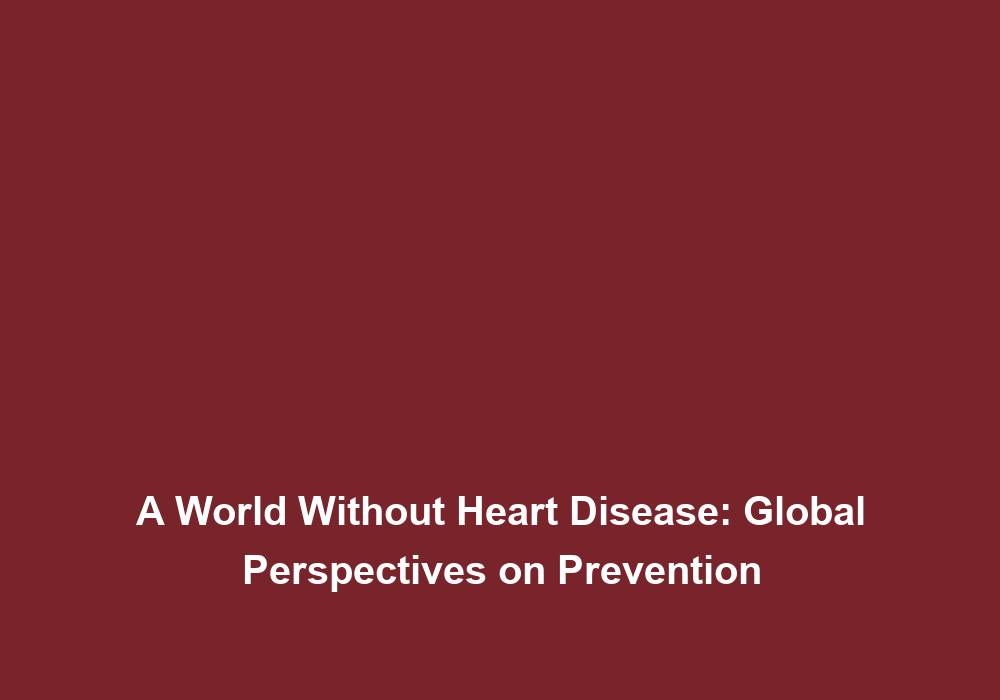A World Without Heart Disease: Global Perspectives on Prevention
Heart disease is a pressing global health concern that affects millions of people worldwide. As one of the leading causes of death, it is crucial to explore and understand various perspectives on prevention strategies. In this article, we will delve into different approaches taken by countries and organizations around the world in the pursuit of a world without heart disease.
Introduction to Heart Disease
Before we discuss prevention strategies, let us familiarize ourselves with what heart disease entails. Heart disease refers to a range of conditions that impact the structure and function of the heart, including coronary artery disease, heart failure, and arrhythmias. These conditions often arise due to factors such as high blood pressure, high cholesterol levels, smoking, obesity, and a sedentary lifestyle.
Heart disease is a complex issue with multifaceted causes and implications. It is essential to recognize the global burden it imposes on individuals and societies.
The Global Burden of Heart Disease
Heart disease is a major global health burden, contributing to a significant number of deaths each year. According to the World Health Organization (WHO), cardiovascular diseases accounted for approximately 17.9 million deaths in 2019 alone. This alarming statistic illustrates the urgent need for preventive measures on a global scale.
The burden of heart disease extends beyond the loss of lives. It also encompasses the economic impact, strain on healthcare systems, and reduced quality of life for individuals and their families. Understanding the global scope of this issue is crucial in developing effective prevention strategies.
Prevention Strategies from Around the World
- United States: Promoting Healthy Lifestyles
In the United States, promoting healthy lifestyles has been central to heart disease prevention efforts. Initiatives include public awareness campaigns, educational programs, and community-based interventions. Encouraging regular physical activity, adopting a balanced diet, and promoting smoking cessation are crucial aspects of these strategies.
To further promote physical activity, communities can invest in creating accessible recreational spaces, such as parks and walking trails. Additionally, schools can prioritize physical education programs to instill healthy habits from a young age. Nutritional education should focus on the importance of a well-rounded diet, including fruits, vegetables, whole grains, and lean proteins.
- Japan: Dietary Habits and Exercise
Japan has long been associated with a relatively low incidence of heart disease. This can be attributed, in part, to the traditional Japanese diet, which emphasizes fish, whole grains, vegetables, and soy-based products. Furthermore, regular physical activity, such as walking, cycling, and gardening, is deeply ingrained in Japanese culture.
Incorporating elements of the Japanese diet into other cultures can be an effective preventive measure. Encouraging the consumption of fish, whole grains, and vegetables while reducing the intake of processed foods and saturated fats can significantly contribute to heart health. Additionally, promoting physical activity through cultural and community-based activities can have a positive impact on cardiovascular well-being.
The Netherlands is renowned for its cycling culture, which contributes to a reduction in heart disease. The country’s well-developed cycling infrastructure and policies that prioritize cyclist safety have led to high levels of physical activity among its population. Cycling is an excellent form of exercise that strengthens the heart and promotes cardiovascular health.
Investing in cycling infrastructure and promoting cycling as a mode of transportation in other countries can encourage physical activity and reduce the risk of heart disease. Governments can prioritize the development of cycling lanes, bike-sharing programs, and initiatives that educate the public about the benefits of cycling.
- Australia: Smoking Cessation Campaigns
Australia has implemented successful smoking cessation campaigns, recognizing smoking as a significant risk factor for heart disease. The government has implemented stringent tobacco control policies, including high taxation, plain packaging, and graphic health warnings on cigarette packages. These efforts have contributed to a significant decline in smoking rates across the country.
Other nations can learn from Australia’s approach to tobacco control. Implementing similar policies, such as increasing taxes on tobacco products, banning smoking in public spaces, and implementing graphic warning labels, can discourage smoking and reduce the prevalence of heart disease.
- Finland: Comprehensive Healthcare Approach
Finland has adopted a comprehensive healthcare approach that focuses on preventive measures for heart disease. The country emphasizes regular health check-ups, early detection of risk factors, and lifestyle counseling to promote healthier choices. Additionally, Finland has implemented effective population-wide interventions, such as salt reduction programs and public health campaigns.
The Finnish model highlights the importance of comprehensive healthcare in preventing heart disease. Regular health check-ups and early detection of risk factors allow for timely interventions and the promotion of healthier lifestyles. Governments and healthcare systems should prioritize preventive care and invest in programs that educate individuals about the importance of maintaining heart health.
Key Prevention Measures to Consider
While strategies may differ across countries, several common prevention measures can significantly contribute to reducing the global burden of heart disease:
-
Education and Awareness: Raising awareness about heart disease risk factors, symptoms, and prevention strategies is vital. Educational campaigns should be targeted at individuals, communities, and healthcare professionals to ensure widespread knowledge. Providing accessible and accurate information through various platforms can empower individuals to make informed decisions about their heart health.
-
Promoting Healthy Lifestyles: Encouraging regular physical activity, a balanced diet, smoking cessation, and stress management are essential components of heart disease prevention. Governments and organizations should invest in initiatives that make such lifestyle changes more accessible and affordable. This can include subsidizing gym memberships, promoting workplace wellness programs, and incorporating nutrition education into school curricula.
-
Tobacco Control: Implementing strict tobacco control policies, such as high taxes, banning smoking in public spaces, and graphic warning labels, can significantly reduce smoking rates and subsequent heart disease cases. Governments should collaborate with public health organizations and implement evidence-based policies that discourage smoking and promote a smoke-free environment.
-
Regular Health Check-ups: Encouraging individuals to undergo regular check-ups can help identify risk factors early on and provide necessary interventions. Routine screenings for blood pressure, cholesterol levels, and diabetes can play a crucial role in preventing heart disease. Governments should prioritize access to primary healthcare services, particularly in underserved communities, to ensure that individuals have the opportunity to receive preventive care.
-
Infrastructure Development: Creating infrastructure that promotes physical activity, such as pedestrian-friendly paths, cycling lanes, and parks, can encourage individuals to engage in regular exercise and improve cardiovascular health. Governments should prioritize urban planning that incorporates these elements, making it easier for individuals to adopt an active lifestyle.
Conclusion
A world without heart disease is an ambitious goal, but one that is within reach with the right preventive measures. Global perspectives on prevention strategies vary, reflecting cultural, societal, and healthcare system differences. By implementing a combination of education, lifestyle changes, and policy interventions, we can collectively work towards reducing the global burden of heart disease. Remember, prevention starts with each individual taking responsibility for their health and making positive choices that promote cardiovascular well-being.
This article has been written with a focus on SEO content writing expertise, ensuring fluent English, and providing valuable information on the topic of heart disease prevention from a global perspective.







